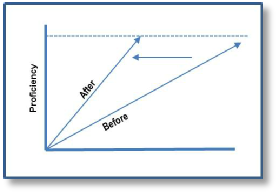Follow Us




Learning Paths International
A Process Improvement Approach to Learning
Every minute employees are less than fully proficient has a significant impact on productivity, sales, quality, error rates, safety and more. Ensuring that employees reach full proficiency while reducing time to proficiency is at the core of the Learning Paths approach. For salespeople this means reaching sales goals weeks or months earlier. In manufacturing, this means reducing accidents by making workers safer sooner while improving the quality of their work. For health care workers it means providing a higher level of care without the need for constant supervision.
Defining Proficiency
The Learning Paths approach starts by building a concise, complete and measurable definition of proficiency. We define proficiency as the measurable outcomes and observable behaviors of doing a job or task correctly at the desired level of performance. Once we have a definition of proficiency, we can determine current time to proficiency and set a goal of reducing time to proficiency by at least 30%. In addition, the proficiency definition becomes a valuable assessment tool.
Learning as a Process
Next, we look at learning as a process rather than a single event or series of courses. In fact, we look at the entire learning process from day one all the way to proficiency. We call this a Learning Path. What we find is that most learning is happening on the job and is usually informal, highly unstructured and highly variable. By viewing learning as a process, we are then able to apply process improvement tools to improve learning by taking out time, waste and variability. It also gives us tools to restructure and resequence the process in a way that improves retention and transfer to the job.
Learning Paths Projects
Individual Learning Paths projects start by targeting a critical job, function or task. Usually these involve front line employees and first line supervisors. We start with these functions because they have the greatest and most immediate impact on the organization. Next we form a Learning Paths team of stakeholders in order to build and launch a new Learning Path in as little as six to eight weeks.
Installing Learning Paths throughout your organization can quickly be done by developing and certifying internal Learning Paths project leaders. We also work with you to set up a system to monitor and track the progress of all Learning Paths as well as share best practices from one path to another. If you’re looking for a a quick start check out our 30/30 Plan.
Copyright Learning Paths International 2014




Reducing Time to Proficiency
Time
30 to 50%
Improvement
100%
TM
Learning Paths
Learning Paths
TM
Learning Paths
TM
Learning Paths
TM
TM

Learning Paths Book